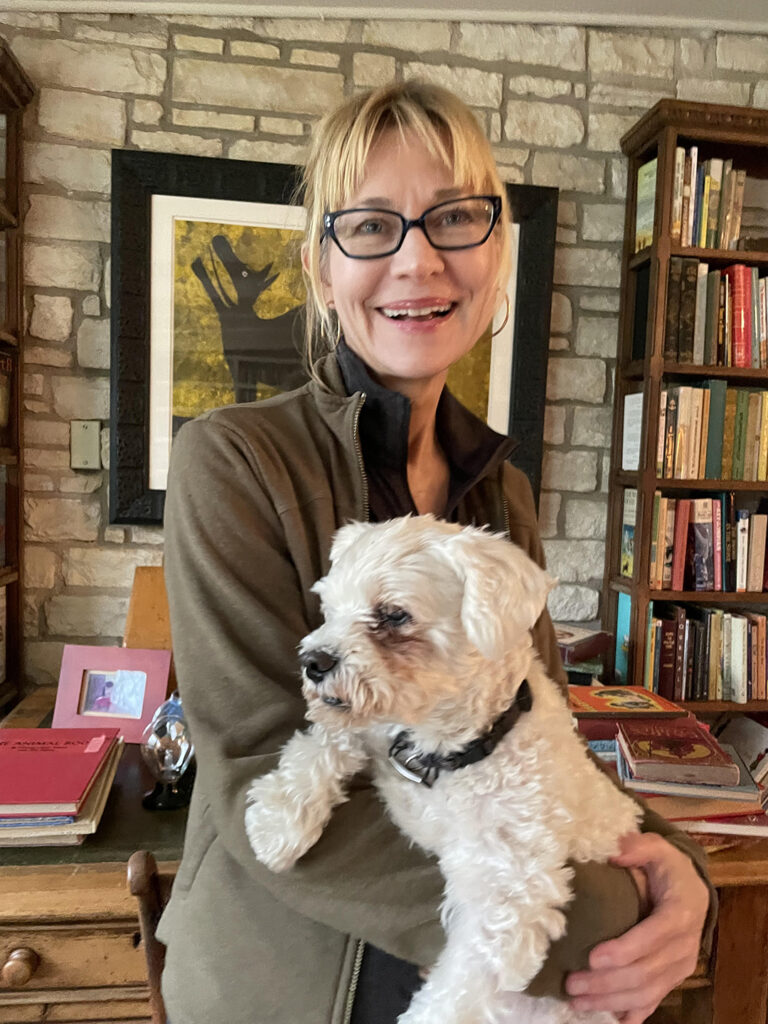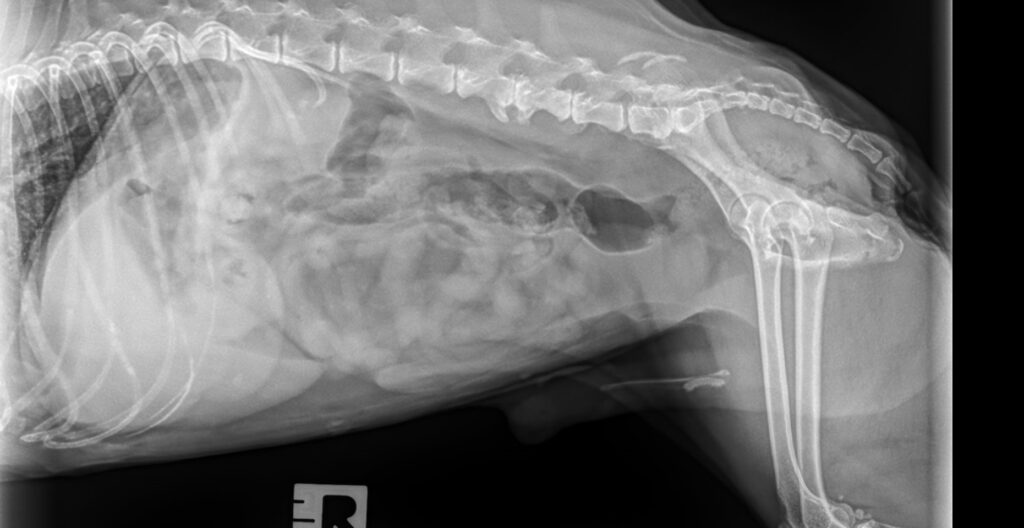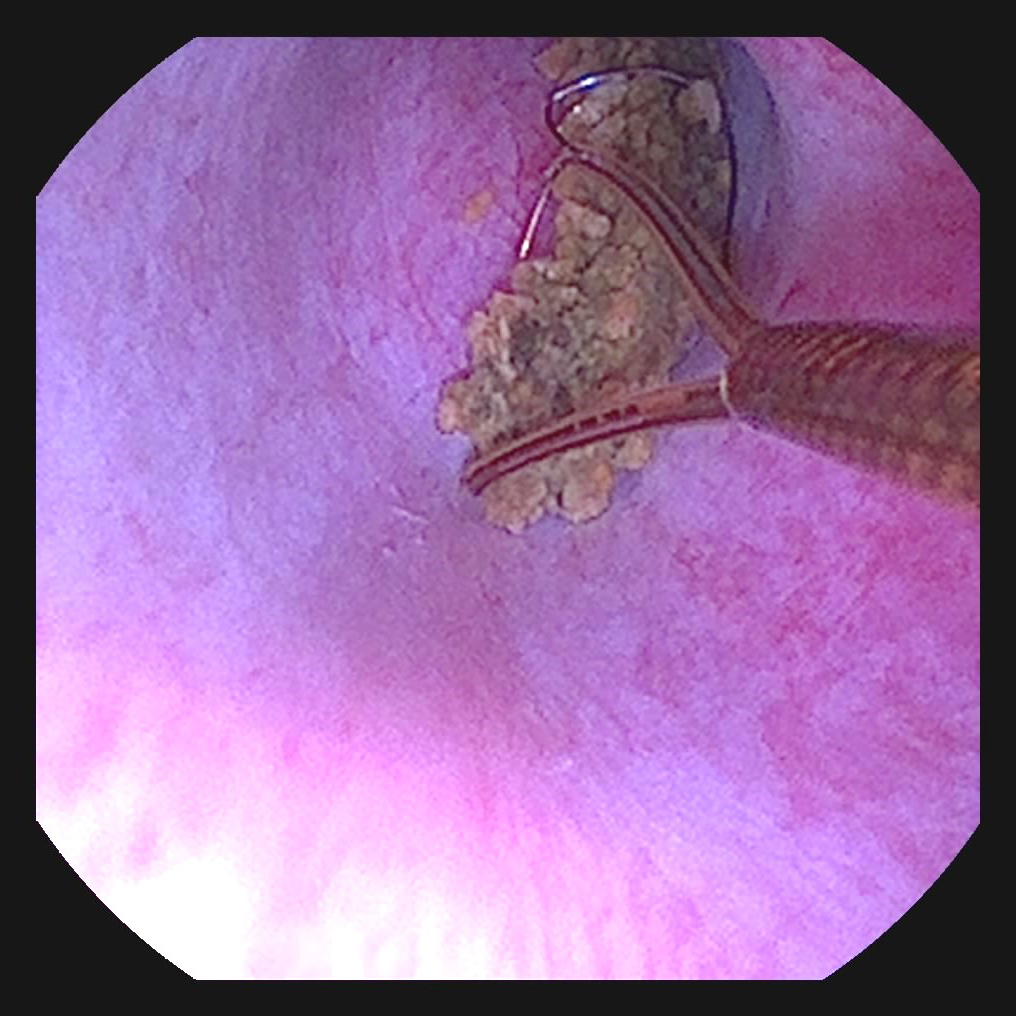Texas A&M Veterinarians Remove Oddly Shaped Kidney Stone From Dog’s Urethra
Story by Courtney Price, VMBS Communications

When acclaimed Texas author Elizabeth Crook began writing her recent novel, “The Madstone,” she never anticipated that veterinarians would find a “madly” shaped stone inside her own beloved dog, Francis.
Crook’s novel takes its name from a type of stone in American folklore made up of minerals and other materials that would accumulate into rock-like structures in the digestive systems of ruminant animals, most specifically deer. Madstones, as they were called, were believed to draw the virus out of a rabid animal’s bite and prevent rabies from developing.
Unfortunately, unlike madstones, Francis’ stone was not helpful, though it did have its own fascinating properties. Made of small bladder crystals that had formed into one piece that was several centimeters long, the strange sea cucumber-shaped urinary stone made urination difficult and painful.
Thankfully, veterinarians at the Texas A&M Small Animal Teaching Hospital (SATH) were able to remove the stone from inside the 12-year-old miniature schnauzer’s urethra using a special flexible scope, putting Francis on the road to recovery.
Diagnosing The Problem
Francis entered Crook’s life on her son’s 16th birthday.
“My son, Joseph, had a friend whose dog had given birth to a litter of puppies. He really bonded with one of the puppies, so the friend gave the pup to him as a birthday present and Joseph named the little guy Francis,” Crook said. “We already had a dog, but my husband and I talked it over and agreed to let my son keep him.”
But it was Francis and Crook who soon developed a special bond.
“He was just 6 weeks when Joseph brought him home and put him in my arms,” she said. “He’s been by my side, on my lap, or in my arms ever since.”
Francis is particular about who his favorite person is.
“He relates to the whole family, but he’s very much my dog,” Crook said. “He follows me from room to room all day, and he’s also protective. He’s small, but he’ll take on any stranger he deems suspicious.”

However, it was Crook’s turn to be concerned last spring when Francis appeared to be having problems urinating.
“He’d had two previous surgeries for bladder stones, so we’re very careful to keep him on a prescription diet for urinary health and watch out for signs,” Crook said. “Once a week, my husband goes out with a ladle and collects a urine sample that we test for pH level and white blood cells.”
So, when Francis suddenly began urinating slowly and painfully, Crook knew he needed to see a veterinarian immediately.
“Our regular veterinarian, as well as local specialists, were able to see the stone in X-rays but didn’t have the equipment to extract it,” she said.
No Stone Unturned
On a friend’s recommendation, Crook turned to the veterinarians at the SATH for help removing Francis’ strange bladder stone.
“I’d never before seen a urinary stone with such an unusual, elongated shape,” said Dr. Audrey Cook, an internal medicine specialist and professor in the School of Veterinary Medicine & Biomedical Sciences’ Department of Small Animal Clinical Sciences. “We first ran diagnostics to make sure there weren’t any other undetected stones, and then we took him to surgery the next day.”
The normal approach for treating this issue is to try to push the stone back into the bladder for removal, but the stone’s odd shape prevented this method from working.
“Since pushing didn’t work, we decided to pull it out using a small, flexible scope to grab the end,” she said. “It worked perfectly, and we were able to send Francis home the next day.”

When it comes to removing stones in the bladder and urethra, the veterinarians at the SATH have many techniques at their disposal.
“If it had come down to it, we also have a laser that we can use to break up stones,” Cook said. “Thankfully, Francis’ stone wasn’t so stubborn that we needed to use it.”
Cook said urinary crystals are a common problem among miniature schnauzers due to the way their bodies process calcium.
“Schnauzers are very vulnerable to getting these stones in their urine,” she said. “If you own a schnauzer, one thing you can do to prevent stones is make sure they drink lots of water and eat wet food instead of dry.”
A Fitting Epilogue
Since the procedure, Francis has been doing well and is enjoying traveling with Crook on her book tour.
“It was so strange to have this happen while I was working on ‘The Madstone’,” Crook said. “Francis’ stone had a different composition than the stones I had read about for my research, but it was essentially still a strange rock formed inside an animal.”
As a token of her appreciation, Crook sent a copy of her now-published book to several of the clinicians who worked on Francis’ case.
“I felt so grateful,” she said. “Because of the title, the book made a fun way to say thanks.”
“I was very touched,” Cook said. “I’ve been enjoying reading it.”
Francis’ care at the SATH has also made a new Texas A&M fan out of Crook.
“I graduated from Rice University, and my husband teaches at the University of Texas at Austin, but I’ll be rooting for A&M from now on,” she said.
###
For more information about the Texas A&M School of Veterinary Medicine & Biomedical Sciences, please visit our website at vetmed.tamu.edu or join us on Facebook, Instagram, and Twitter.
Contact Information: Jennifer Gauntt, Director of VMBS Communications, Texas A&M School of Veterinary Medicine & Biomedical Sciences, jgauntt@cvm.tamu.edu, 979-862-4216


